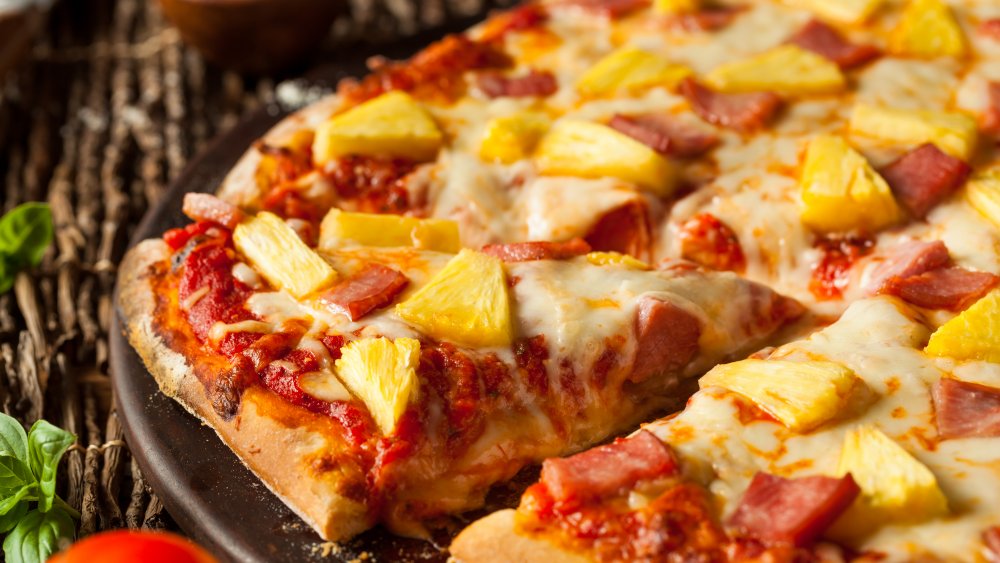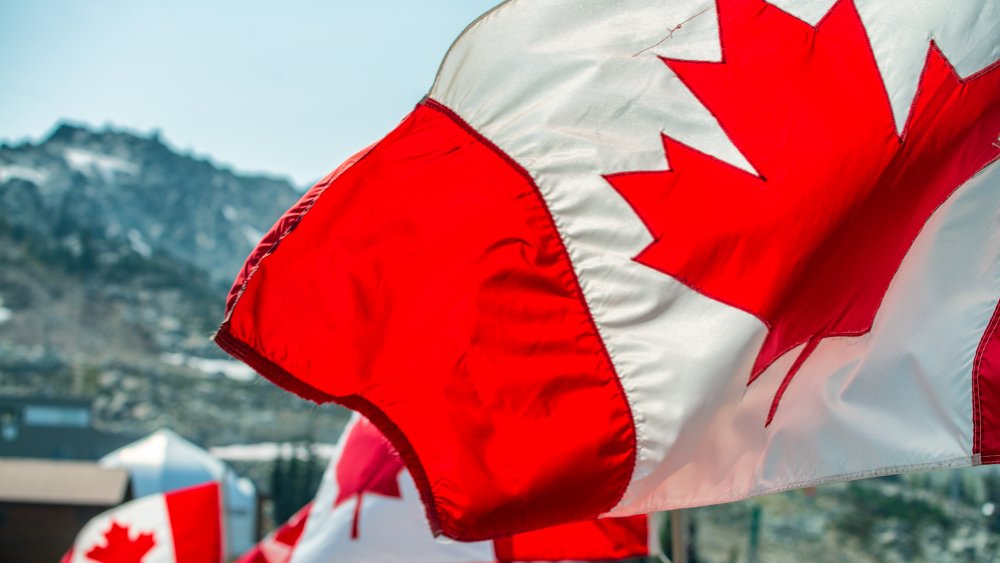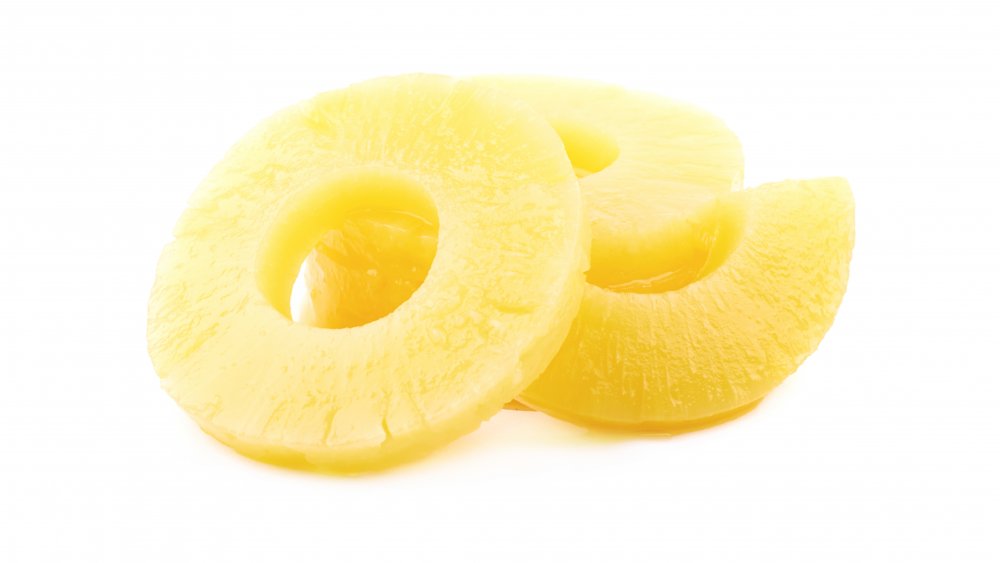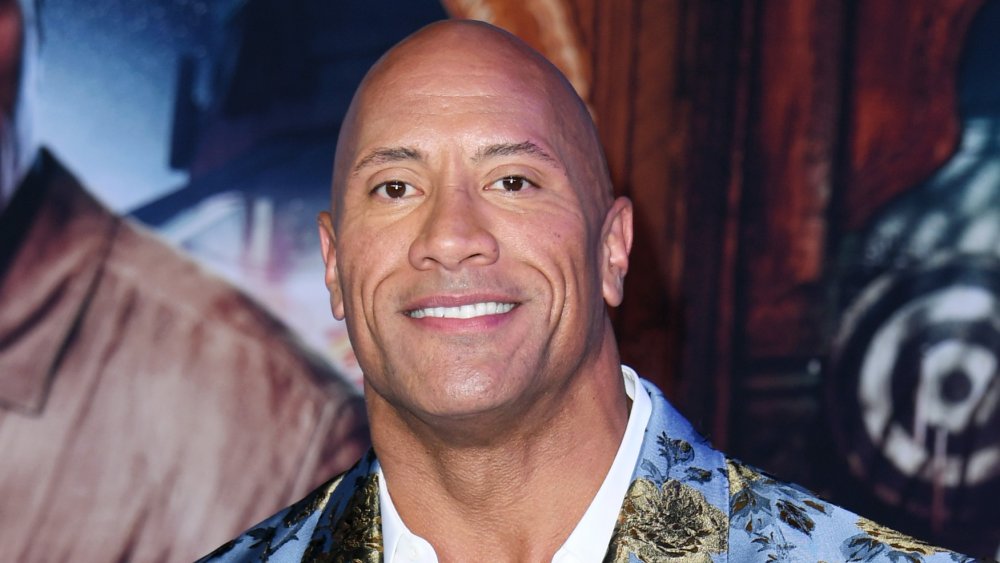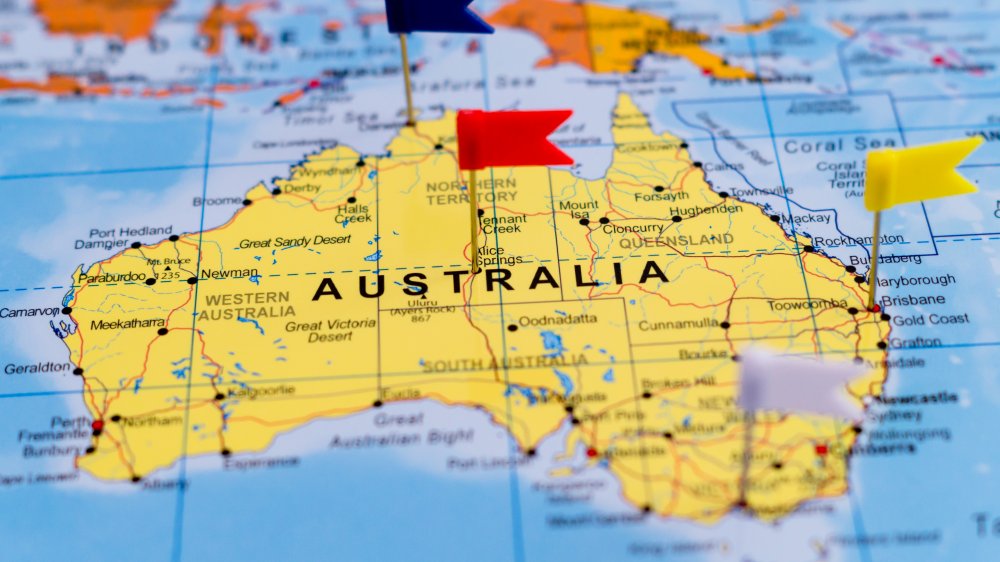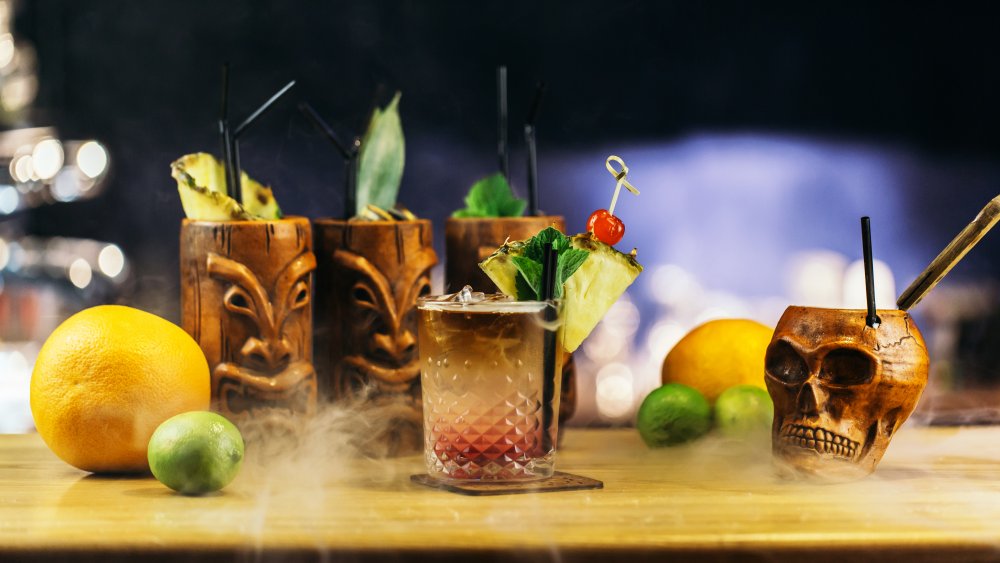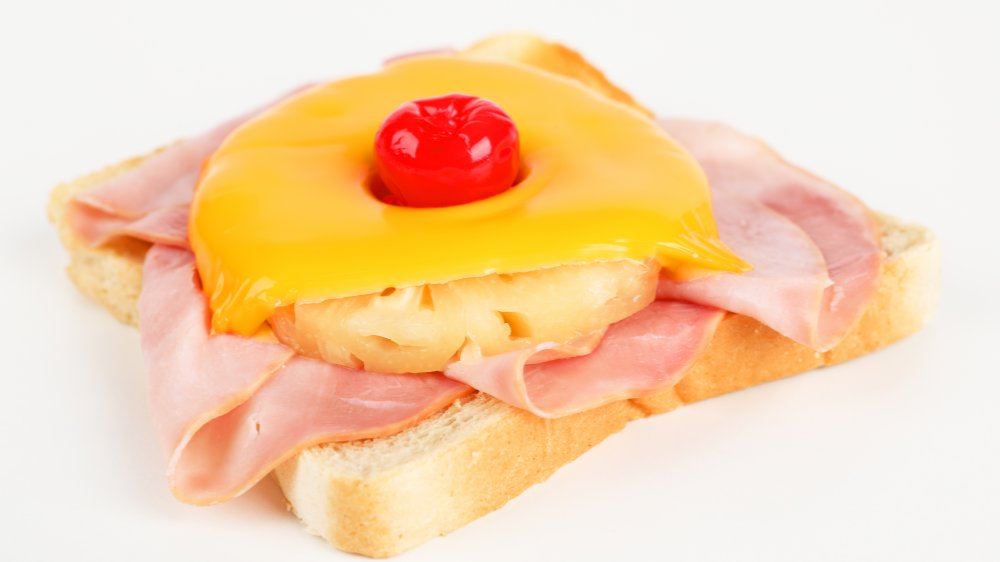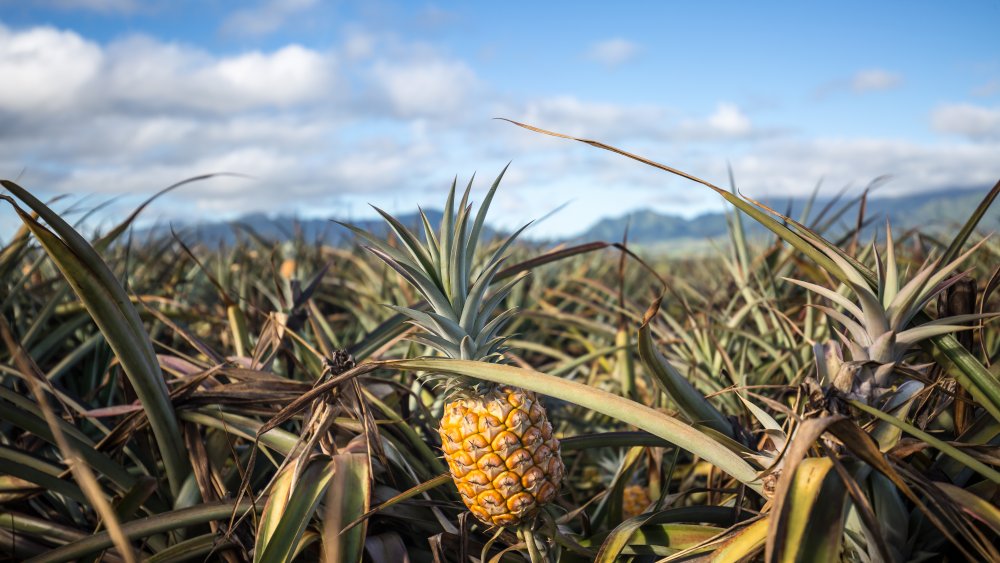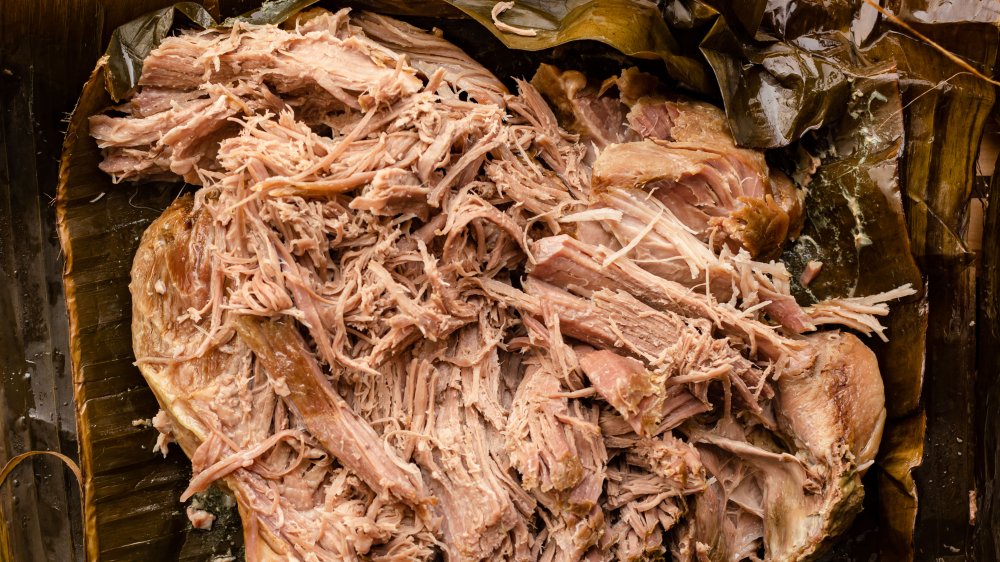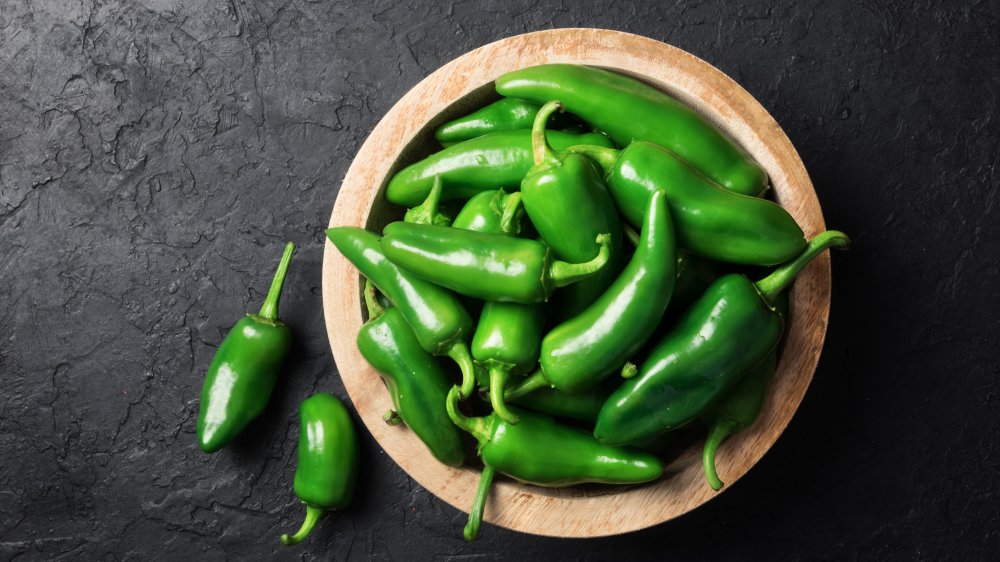Here Are The Facts About Hawaiian Pizza
It's January, it's freezing outside, and you're scraping the ice off the windshield of your car, thinking: Do I have enough frequent flyer miles to go to Hawaii? If the answer is yes, good for you. But if not, well, you could just have Hawaii on a pizza instead. Not a great consolation prize, sure, but love it or hate it, if you've ever ordered pizza, you've likely had the option of ordering a Hawaiian pizza. Whether it's the classic ham and pineapple combo, or ham, pineapple, and bacon, it's almost as ubiquitous as pepperoni and cheese.
Named after the United States' 50th state, you could argue that the Hawaiian pizza is an early example of a fusion dish: pizza, an Americanized Italian dish, gets the kitsch "tiki" treatment. Italian pizza purists, please resist the urge to punch your computer screen. Once you've finished reading, feel free to drown your sorrows in a nice Sangiovese (which pairs well with a margherita pizza). Is Hawaiian pizza all that it seems? Where did it come from? And why do so many people hate the fact that other people put pineapple on pizza?
Hawaiian pizza is actually Canadian
Not only is Hawaiian pizza not actually from Hawaii, it's not even from the United States. Sotirios (Sam) Panopoulos immigrated to Canada from Greece in 1954 and opened the Satellite Restaurant with his brother in London, Ontario. When the Satellite hired a Chinese–Canadian cook and started adding some sweet and savory dishes to the menu, the inspiration for pineapple on pizza was born.
But the idea for making pizza at the restaurant at all came after a trip to nearby Windsor, when Panopoulos first tasted pizza, a food trend that was slowly trickling into Canada. In an interview with the CBC, Panopoulos said, "Along the way we threw some pineapples on it and nobody liked it at first. But after that, they went crazy about it. Because those days nobody was mixing sweets and sours and all that. It was plain, plain food."
Panopoulos later added ham to the pizza and named the pizza "Hawaiian" after the brand of canned pineapple he used.
For a pizza topping, Hawaiian pizza is surprisingly controversial
For a humble pizza topping, pineapple often inspires some very strong feelings. You would think that what someone else chooses to put on a pizza affects no one but that person, but in the case of Hawaiian pizza, you would apparently be dead wrong. See the title of this Wall Street Journal article: "A Divided Nation Reveals Itself In One Question: Hawaiian Pizza, Yes or No?" Terms like "divided nation" are usually reserved for slightly more consequential issues like nuclear warfare or whether the toilet paper roll should be facing in or out, but it is appropriate for the level of vitriol that Canadian/Hawaiian pizza brings forth.
According to a 2017 poll by Public Policy Polling, the United States is, in fact, a nation divided over whether or not pineapple is an acceptable pizza topping. According to the data, 47 percent of Americans approve of pineapple on pizza, 32 percent disapprove, and 20 percent are not sure about the combination. That same year, Gordon Ramsay ordered a pizza live during a taping of a British late-night show, and when an audience member suggested pineapple as a topping, Ramsay responded: "You don't put f***ing pineapple on a pizza." Hawaiian pizza haters on social felt vindicated. Why can't we all just get along?
The President of Iceland threatened to ban Hawaiian pizza
In a question-and-answer session with high school students in Northern Iceland, one cheeky pupil asked Iceland's President, Guðni Th. Jóhannesson, what he thought about pineapple as a pizza topping. The president did not hold back, telling the student that, if he had the power to pass laws, he would ban it in Iceland. Twitter had a field day with the statement. DiGiorno saw a great marketing opportunity, tweeting a picture of its Hawaiian pizza with the caption "No ban here."
After a great deal of hubbub on social media, President Jóhannesson released a statement on social media that read, "I like pineapples, just not on pizza. I do not have the power to make laws which forbid people to put pineapple on their pizza. I am glad that I do not hold such power. Presidents should not have unlimited power. ... For pizzas, I recommend seafood." Honestly, we're not sure if that sounds like a better option or not.
The Canadian Broadcasting Corporation reached out to Sam Panopoulos for his rebuttal to the President of Iceland's comments. Panopoulos said, "He can say whatever he wants. He sells the fish over there, you know, that's all he does. So he has to put the fish on the pizza."
Hawaiian pizza does have some pretty high-profile defenders
If you've read this far, you probably think everyone hates Hawaiian pizza, but that is simply not true. In response to the President of Iceland Incident of 2017, Canadian Prime Minister Justin Trudeau took to Twitter, saying: "I have a pineapple. I have a pizza. And I stand behind this delicious Southwestern Ontario creation. #TeamPineapple."
Dwayne "The Rock" Johnson, a man the size of a fridge who is not to be messed with, wrote in an Instagram caption, "As for my pizza toppings — keep in mind, I'm the guy who likes to put tequila and brown sugar in my oatmeal, so pineapple on pizza is MY JAM — with ham." It follows that, according to Johnson, if you think that Hawaiian pizza is a crime against pizza, to quote The Rock's WWE catchphrase, "It doesn't matter what you think."
Actor Jeff Goldblum said in response to a question from a fan that, "Like there's no bad dog, there's no bad pizza. I love pineapple on pizza." Goldblum continued, "I love anchovies on pizza." Woah, slow your roll, Jeff.
Hawaiian pizza is popular in Australia ... but pineapple's not as popular in the U.S.
According to PMQ Pizza Magazine, Hawaiian pizza and chicken pizza each account for 15 percent of all pizza sales in Australia. (Australians also tend to prefer pan pizzas to hand-tossed pizzas). Why does the land Down Under prefer ham, pineapple, and chicken to more "normal" pizza toppings? Tom Potter, President of Australia's second-largest pizza chain at the time of the article's publication, Eagle Boys, explained, "Australians have a blander taste in food than do Americans."
But American taste is not a monolith, either. It's a big country, and Italian–American food culture is strongest in the Northeast and parts of the Midwest. This is reflected in the results of a YouGov poll on the ever-provocative question, "Does pineapple belong on a pizza?" Only 12 percent of Americans who eat pizza claim that pineapple is one of their favorite toppings, with younger Americans (15 percent) and Americans living in the western part of the country (17 percent) saying pineapple is one of their faves.
However, Americans from the Northeast and those over the age of 55 were particularly likely to have pineapple as a least favorite pizza topping, with 28 percent of each group putting the Hawaiian pizza in more of the "hard no" category.
Hawaiian pizza rode in on a wave of 1960s tiki culture
Hawaii became the 50th U.S. state in 1959, and America spent the next decade obsessing over it. Before 1960, Hawaii's economy had revolved around pineapples and sugar cane, but from the '60s onward, tourism became the driving engine of Hawaii's economy. That Hawaii's statehood also coincided with an age of proliferation of air travel was another major factor in Hawaii becoming the ultimate American vacation destination. Traveling to Hawaii had once been only for the extremely adventurous or rich, but now, the middle class could travel to America's "most exotic state."
Hawaii loomed large in 1960s pop culture. Elvis made three movies in Hawaii. The series Hawaii 5-0 became a huge hit. Surf music dominated the pop charts (Suddenly, the Beach Boys make a lot more sense, right?). And tiki culture became ubiquitous. Polynesian-themed lounges and hotels popped up all over America. Hawaiian pizza, you could argue, was just the cultural phenomenon of leis, dancing hula girls, and Mai Tais on a bed of tomato sauce and cheese.
Hawaiian pizza was preceded by the German snack known as Toast Hawaii
A few years before Sam Panopoulos had the salty/sweet stroke of genius that created Hawaiian pizza, some Germans were chowing down on a similar dish. Originating in the German-speaking area of Switzerland and popularized by West German TV host Clemens Wilmenrod, Toast Hawaii is reminiscent of Hawaiian pizza except that it is an open-faced sandwich that layers ham, pineapple, and melted cheese with a cherry on top.
In a Reddit thread about the dish, there was some controversy about whether or not the cherry was an authentic, German part of Toast Hawaii, with a few users claiming that they've only seen the cherry in photos on menus or in cookbooks. If you'd like to make Toast Hawaii and the cherry is scaring you off, there's a recipe that uses a spoonful of cranberry jelly instead. Hawaiian pizza lovers, maybe you should give this a try.
What's so Hawaiian about pineapples and ham on Hawaiian pizza?
Pineapples are not native to Hawaii, but they have become closely associated with the state. Pineapples originally came from South America, spreading from Brazil to Mexico and the West Indies. Columbus brought them back to Europe, and pineapples, along with oranges and limes, became excellent fruit to bring along on long ocean voyages due to their high vitamin C content, which helps prevent scurvy.
On one such voyage, Spanish missionaries likely brought the pineapple to Hawaii. The Hawaiian pineapple industry didn't really take off until marketing-savvy James Dole opened the Hawaiian Pineapple Company in 1901, introducing pineapple to the American mainland and turbocharging Hawaiian agriculture.
As for ham, while we've established that the OG Hawaiian pizza was made with Canadian bacon, there is something about Hawaii and ham, or rather, Hawaii and Spam. Per capita, Hawaiians consume more of the Hormel Foods meat in a can than anywhere else in the United States, with about six cans per year going for every person on the islands. Spam musubi is a classic Hawaiian snack made from spam, rice, soy sauce, and furikake all wrapped up in crispy nori.
The Flatbread Company in Maui claims to make real Hawaiian pizza
It's fair to say that most Americans' understanding of Hawaii is often problematic. As the 1960s and 1970s brought an explosion of Polynesian-themed hotels and tiki lounges to the mainland, it seemed that some people forgot that Native Hawaiian culture isn't just a kitschy theme for parties.
But times have changed, and the America that built a large Polynesian-themed dining club, the Kahiki Supper Club, in Columbus, Ohio, of all places, was a different America. (The Kahiki Supper Club was torn down and is now a Walgreens). Still, for most of us on the mainland, the "real Hawaii" remains a mystery.
A pizza restaurant on Maui, the Flatbread Company, aims to make a "real" Hawaiian pizza using locally sourced ingredients and recipes. Instead of ham, it uses kalua pork, mango barbecue sauce, red onions, Hawaiian goat cheese, mozzarella, Parmesan, and fresh pineapple. Kalua pork is a slow-cooked pork that's considered a staple dish at any luau. The Hawaiian word kalua means "baked in an earth oven."
You can go crazy and add jalapeños to your Hawaiian pizza
A lot of people think putting pineapple on pizza is straight-up crazy, but what would happen if you ditched the ham or bacon and added jalapeños to your pineapple-topped pizza? Make it vegetarian, make it spicy, and maybe make your friends think you've lost your mind. Gawker writer Kelly Conaboy points out that, although her friends would react in horror whenever she would suggest ordering such a pizza, if you google the combo, "Google goes on and on. Jalapeño and pineapple recipe after jalapeño and pineapple recipe. Don't believe me? Google it yourself, then, I dare you."
Salon writer Amanda Marcotte recalls a pizza place in Austin, Texas, that sold a pineapple jalapeño pizza under the name "the stoner special," and she argues that pineapples and jalapeños work best on cheap, takeout-style pizza because they pack a punch to make up for the lack of quality ingredients.
However you enjoy your pizza, whether it's thin crust or deep dish, artisanal or cheap-o, just remember: You are allowed to put pineapple on pizza, whether you're going for a Hawaiian pizza or not. There's no law against it (yet).
